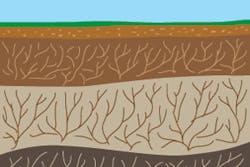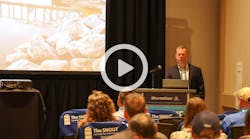Cost-Effective Erosion Control With Blankets and Mats – Part 2
Highways Versus Commercial and Residential Development
According to Craig Momose, a civil engineer with the civil engineering consulting firm of Stackhouse, Seitz & Besinger in Reading, PA, erosion control blankets and TRMs find their greatest use in the temporary or permanent protection of newly constructed and seeded drainage channels, swales, or ditches along highways and in new commercial and residential developments. The Berks County Soil Conservation District and others in the state require that a temporary erosion control blanket be used on newly seeded slopes steeper than 3:1. But the majority of applications for erosion control blankets, Momose believes, are for temporarily lining channels and ditches until a dense stand of grass can be grown to provide natural protection.
Steeper slopes are more common in highway work than in private developments, Momose observes, because highway rights of way are often narrow, forcing the highway designer to construct a steep slope. Private developers, on the other hand, are grading wider expanses to avoid creating steep slopes on their sites, which inhibit the land’s usefulness. Most steep slopes requiring temporary blanket protection lie along new highways or reconstructed sections of existing highways–not on established highways, where long-established stands of grasses continue to protect slopes against erosion.
Landfills are another area, Momose points out, where steep slopes are to be found and where temporary erosion control blankets are often used to protect newly seeded slopes until a dense stand of grass can be grown. Typically a landfill will have a 20-foot-long slope (walking transversely down the landfill), then a horizontal bench, then another 20-foot-long slope, and so on. Stormwater flows down the 20-foot-long slopes and is collected by channels running along the bench area. These channels then conduct collected stormwater to an onsite detention basin. Temporary blankets protect the slopes, and permanent TRMs armor the channels.
Momose points out that blankets are not typically used for protecting the vast majority of newly graded and seeded areas: that is, those newly graded areas that are flat or moderately sloped (up to 3:1), which includes 90–95% of the cases. There are more cost-effective ways of dealing with such less demanding situations, Momose maintains. In Pennsylvania, the workhorse method for seeding and mulching newly graded areas that are relatively flat is hydroseeding or hydromulching. In this long-established method, water, seed, fertilizer, a mulch (usually a paper or wood fiber), and a tackifier (to help bind mulch fibers to one another and to the soil) are mixed in a tank and sprayed on the soil. Sometimes a straw or hay mulch is machine-applied afterward. Pennsylvania requires contractors to mulch all seeded areas at the rate of 3 tons of mulch per acre, even on flat areas–more than is really necessary, Momose believes.
Taking note of those engineers and organizations trying to save money by hydroseeding slopes steeper than 3:1, Momose sums up his stance: “Yes, it is true that using an erosion control blanket may cost more initially than just seeding and hydromulching. But in the long run, installing a blanket may be cheaper to the owner because he then won’t have to have someone go back later to repair erosion damage and to reseed.”
Blankets and Mats for Slopes and Channels
Numerous channels (typically 8–10 ft. wide), swales, and ditches are constructed both on highway projects and in commercial and residential developments. For instance, in a residential development, ditches running alongside an uncurbed road are there to carry stormwater to a nearby detention basin. In some cases, storm sewers in a development will carry stormwater to a swale, which in turn will convey the water to a detention pond.
For slopes, the designer needs to consider both steepness and the transverse length of the slope–i.e., the walking distance from the top to the bottom of the slope. The longer this is, the faster the sheet-flow stormwater is moving by the time it reaches the bottom of the slope, thus the greater the shear force or erosive force it exerts on the soil or on a protective blanket.
What types of products does a designer have to choose from? Momose believes these are the most popular options in Pennsylvania, listed from least to most costly:
- Light-duty straw blanket, with a plastic (usually nylon or polypropylene) mesh only on the top side–typically lasts three to four months.
- Heavy-duty straw blanket, with a plastic mesh on both the bottom and top–greater fiber density than a light-duty blanket, but similar overall thickness (1/4–3/8 in.). Typically lasts three to four months. Used extensively in Pennsylvania. Momose estimates the installed cost in Pennsylvania is $1.10–$1.40/yd2.
- Combination straw-coir blanket, with a plastic mesh on both the bottom and top–typically lasts one year. Widely used in Pennsylvania, not because of longer life but because of its greater shear strength compared to heavy-duty straw blanket. Coconut fibers have greater tensile strength and last much longer than straw. Momose opts for this combined straw-coir blanket in situations where greater water flows and higher shear forces on the blanket are anticipated–e.g., in protecting a long slope, where water velocities near the bottom will be high. Installed cost is about $2.20/yd2.
- Coir blanket, with a plastic mesh on the bottom and top–a 100% coir blanket can last two to five years or more, coconut fiber being among the most durable of natural fibers, and has the shear strength to resist relatively high water flows.
- Excelsior blanket, with a plastic mesh on the bottom and top–the longer-lasting coir and excelsior, or wood-fiber, blankets are used less frequently in Pennsylvania, where the long growing season and abundant rainfall usually produce an adequate stand of grass on a slope within three or four months. They are common, however, in arid states where it might take two or three years to fully establish a thick stand of vegetation.
- TRMs–intended to provide permanent reinforcement of soil and grass, these mats are usually installed in channels, swales, or ditches. Because they are made from synthetic, durable materials–sometimes with organic materials sandwiched in between layers as well to help nourish vegetation–permanent TRMs are substantially more costly than blankets. Several companies manufacture and market permanent TRMs, among them ACF Environmental, American Excelsior, Colbond Geosynthetics (Enkamat), Maccaferri, North American Green, SI Geosolutions, and RoLanka International. Nedia Enterprises’s KoirMat contains no synthetic materials but can last four to eight years. Many manufacturers offer a wide range of blankets–straw, coir or excelsior, and a mix of straw and coconut.
Synthetic TRMs, suitable for permanently lining channels and ditches, first came on the market about 15 years ago. It was not impossible to get a permanent stand of grass in a channel back then, Momose explains, but it was definitely harder. Back then, a contractor could seed the ditch, spread straw or mulch, then hold it all down by laying a nylon mesh over the entire area. Sometimes such a solution might wash out in a heavy rain, and the entire channel would have to be regraded and reseeded. A rolled mat is faster and less labor-intensive to install and can handle flow velocities too high to be resisted by vegetation alone. The upshot of TRMs is that they have made grass-lined channels and ditches more common and riprap- and concrete-lined ditches less common.


